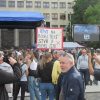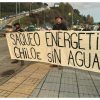Monday, May 6, 2024
News and Views from the Global South
ENVIRONMENT: Alleged U.S. Military Nuclear Accident Investigated
Judith Perera
- The British government continues to reject claims that a serious nuclear accident took place at a U.S. airbase in Britain in the 1950s, but under pressure from the Campaign for Nuclear Disarmament (CND) has pledged an independent review.
A top secret report compiled in 1961 by a group of 60 government scientists on the incident at Greenham Common air base in 1958, found radiation levels in the nearby town of Newbury, Berkshire, several hundred times higher than normal background levels.
Their report, parts of which have been obtained by CND, showed that up to 20 grams of “finely dispersed uranium” had been deposited in a large hourglass-shaped area around the base. CND says this could be the cause of the high levels of leukaemia which occur in clusters around the area.
Previously the levels had been attributed to the Atomic Weapons Research Establishment (AWRE) at Aldermaston and to the British Atomic Energy Agency research centre at Harwell, both of which are in the same area.
The British National Radiological Protection Board has been asked by the ministry of defence to reassess the 1961 report and give its independent opinion on the public health implications.
CND claimed the pledge as a victory. British armed forces minister Nicholas Soames has since declassified the 1961 report and a follow up in 1987, which he says showed that the accident did not pose a risk to public health.
But it was the discovery in 1960 by Aldermaston scientists of elevated radiation levels around the establishment that prompted the secret government investigation in the first place.
The 1961 report, ‘The Distribution of Uranium-235 and Plutonium- 239 around the USAF Base, Greenham Common, Berkshire,’ says the radioactivity must have been released accidentally.
“Further, in order to release 10-20 grammes of finely dispersed uranium, much larger amounts must have been involved in the accident and it seems that the only way such a large quantity could become powdered is through the agency of fire or an explosion,” the report says.
The report links it to an accident which occurred on Feb. 28, 1958 when an American B-47 bomber flying over the base at a height of 8,000 feet developed engine trouble and was forced to drop its fuel tanks.
Instead of falling into the emergency drop zone on the base one of them fell onto a hangar setting it alight and the other destroyed another B-47 on the ground. At the time, U.S. base commander, Colonel Arthur Cresswell, denied that there were any nuclear weapons involved. But the scientists disputed this.
“We suggest that, in fact, a nuclear weapon may have been carried in the aircraft and burned with it,” they concluded in 1961.
The British ministry of defence firmly told IPS that neither the 1958 accident “or any other incident” at Greenham Common involved nuclear weapons.
However, CND points out that in 1956 the U.S. and British governments agreed to deny the involvement of any nuclear weapons in any accidents or incidents involving U.S. nuclear bombers stationed in Britain, a condition since lifted.
Both Aldermaston and Greenham Common served as the main focus for anti-nuclear protests in Britain throughout the 1950s and into the 1980s when the U.S. stationed nuclear-armed cruise missiles at the base.
The scientists’ theory in 1961 was that radioactive debris from the bomb would have been stuck to the runway by foam from the fire- fighting equipment. However this would have been repeatedly disturbed later by vehicle and aircraft movements and by jet blast during takeoff causing radioactive dust to be dispersed to surrounding areas.
The report notes that “the high temperature of the air from the jets would cause it to rise carrying dust and sand particles with it”.
This would explain the hourglass shape of the contaminated area fanning out from the base as there is only a single runway with two take-off directions.
A follow-up study was conducted by AWRE in 1987 which confirmed the excessive radiation and the shape of the contaminated areas. This report was classified as secret, says CND, and its findings also caused the classification status of the original 1961 report to be raised to ‘Secret UK Eyes ‘A’ Named AWRE Distribution Only’.
Another follow-up study in 1994 by AWRE provided further confirmation but was also classified as secret.
“We are satisfied that the 1961 report does not imply levels of contamination that are significant enough to cause concern over public health,” Soames said in a statement this week. However a telephone ‘hot line’ to advise local people worried about health implications was opened by the government on Tuesday.
CND points out that hundreds of thousands of people are at risk from the contamination including tens of thousands who of British and American servicemen who have served at the base (now closed) since the 1950s.
Between 1970 and 1983 there were regular air shows at the base during which the public had access to the contaminated runway.
An IPS correspondent who attended one such show in 1974 recalled that the shows were highly popular precisely because audiences were allowed to sit close along the length of the main runway during the displays, in contrast to other shows that kept them at a distance.
In addition 150,000 people live within the contaminated ‘hourglass’ shaped area. Concern at the high level of radiation linked cancers in the area was first voiced by doctors at the Royal Berkshire Hospital in Reading who wrote a letter to the Lancet medical journal in November 1985 stating that since 1971 their clinics had seen “more children with acute leukaemia than might be expected in a population the size of our health district”.
At the time they were attributed to Aldermaston and the associated nuclear facility at nearby Burghfield. In 1989 the British Government’s Committee on Medical Aspects of the Radiation Environment (COMARE) investigated the situation and confirmed elevated levels of cancers but could find no link with emissions from Aldermaston or Burghfield.
“The findings of the Aldermaston 1961 and 1987 reports could provide the missing link COMARE was looking for,” says CND.
“They clearly detail the dispersal of significant amounts of uranium and plutonium, both of which emit alpha radiation and produce extremely toxic effects inside the body if inhaled or ingested.
CND warns that contamination from Greenham could now have reached groundwaters and be affecting the whole of south east England.

 Print
Print



